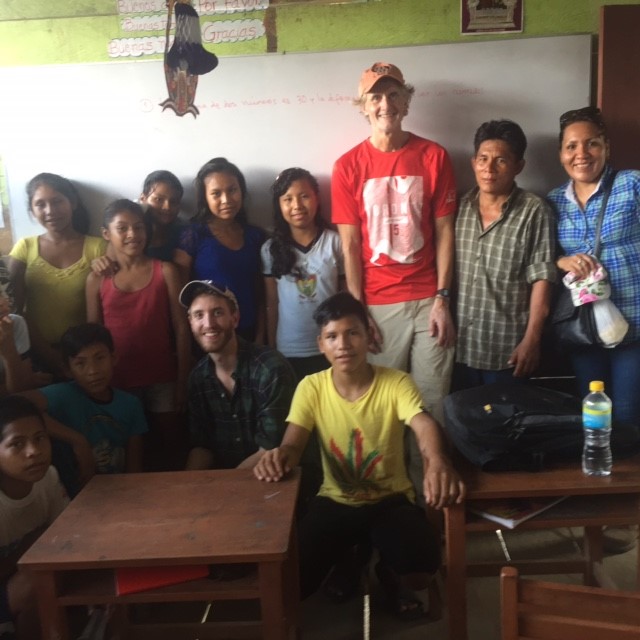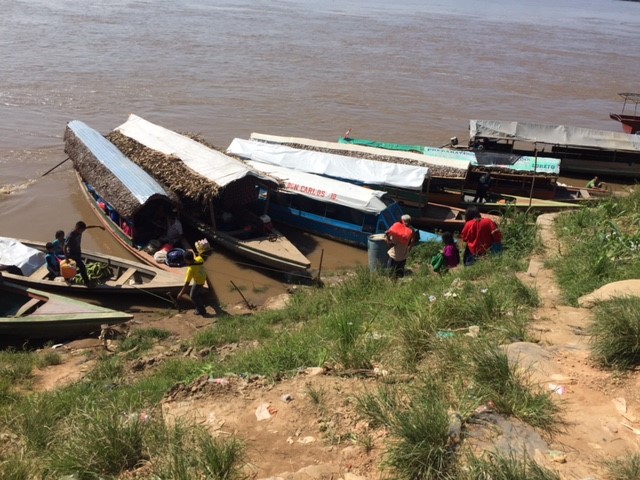
I have for a long time been fascinated with the jungle in general and Iquitos in particular. One of my favourite books “One river” by Wade Davis deals with the upper Amazon area and recently I read “Shamanism, Colonialism and the Wild Man” a book that investigates colonialization, terror and healing in that part of the world. The intersection of these, still to this day, “different” cultures and the white man has made for rich stuff for Anthropologists and has made it for me an exotic, appealing destination.
Iquitos is in the northeast corner of Peru very close to the Columbian and Brazilian borders. It is very isolated: it cannot be reached by road, only by air. It doesn’t feel like Peru at all, much more like Brazil. There are three rivers that come together near Iquitos including the Amazon so one reaches communities in the jungle by boat. As a result it is the jumping off point for journeys down river for places increasingly remote, isolated and deeper into one’s “heart of darkness”. The port has boats of all sizes from canoes with 13hp modified outboard motors to what look like dilapidated old Mississippi River steam ships. The canoes are for day trips, the bigger boats can have destinations as far as 10 days down river. The city itself is a big, dirty, noisy cacophony of urban poverty. Because the river’s water level fluctuates by as much as 30 feet, many houses are on stilts and in these areas there is no sewage system, just outhouses and open raw sewage mixed with garbage.
There are few NGOs here and none that work in education, which is ironic because this district, Loretto, is the poorest in Peru and all education metrics are terrible. So for all of these reasons I have always wanted to work here and three years ago began supporting two local social entrepreneurs who set up small schools in the poorest area of Iquitos – Belen (we visited them I will write about the visits in a separate blog). What we really wanted to do was get down river to communities that have no schools and whose education circumstances are even worse but finding a local person to act as our program manager who was willing to go as far as two days boat travel to reach communities, and stay in communities, with 10 or 20 families in VERY “rustic” circumstances and who also had the administrative skills to fulfill our reporting requirements proved almost impossible. We exhausted every connection that we had in Peru and were almost ready to give up when we found Racquel late last year and hired her as our project manager tasked with identifying communities down river who could use our help. On previous trips to Iquitos Ian found two such communities and we started working in them (Puerto Miguel and San Jose) last year.
Yesterday was my chance to finally be on the Amazon and finally visit our first two community projects there.
We left our hotel at 7am and after a 3-wheeled taxi ride, a 2 hour bus ride, another 3-wheeled taxi then a 2 hour journey in a dugout canoe (with 13hp motor) we reached reached San Jose mid-afternoon. It is a wonderful, small community of 20 families spread out amounts 8 dwellings along a dirt road running up from the river and into the jungle. Our program is running well here, the problem is that the rising river has literally “eaten” (as they say in Spanish) several dwellings and those families have succumbed to the pull of the big city. The population is declining and so next year there may be only 11 children of primary school age which makes it hard for even a small charity like ours to justify the time and expense of working here. It’s a shame because the parents are hugely supportive and even built a schoolhouse for us using their own local trees and labour and our teacher there is also quite good. What I learned: there is a great sucking sound called the call of moving to the city to what appears a better life (but usually is not). I saw today both extreme urban poverty and extreme rural poverty and while neither are pretty nor just and while there is obviously a bigger conversation around this issue, seeing the effects first hand of this demographic movement was for me a little sad.
Puerto Miguel is bigger: 50 families and both a primary and secondary school that draws from other smaller communities down river. Like San Jose there is just one dirt road with wooden dwellings on either side on stilts. We have an academy project here associated with the secondary school. Unfortunately, because it runs after regular school hours, kids from the feeder communities have not been attending regularly so we have only 25 students attending (instead of the 50 we were enrolled). The kids are super enthusiastic and our two teachers are great but the parents don’t seem supportive in this community. Also, there is an “eco lodge” nearby (there are somewhat famous pink river dolphins here) which offers employment opportunities to kids here. That is of course a great thing but causes a dilemma for secondary school kids in our program: why bother trying to enter University and possibly win a Beca 18 scholarship if there are employment opportunities nearby and parents pushing you in that direction? The kids literally asked us this question. We did our best to make the case for higher education, reaching a vocation that speaks to you rather than one that provides only short-term and uncertain money. But it is a complicated question and I’m not arrogant enough to think that I have the answer. What I learned: having nearby employment opportunities is a mixed blessing!
The boat ride back at sunset got a little too thrilling as a huge storm chased us with the sky filling with lightning. The river seemed wide and endless, the lightning everywhere and our little 13hp pretty pathetic. We made it back just as the sky opened up and the rain came down.
-Alan

